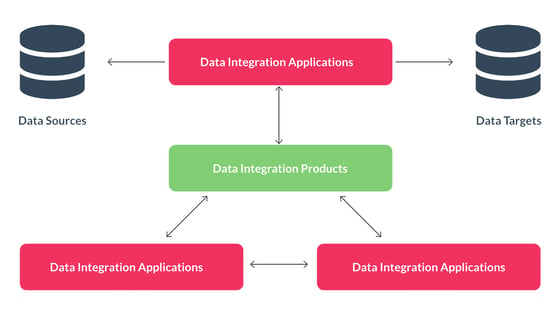What is Data Integration? Simplified
For many professionals, the term data integration is entirely alien. Worse still, lots of the time, explanations of the data integration process require a degree in software engineering to read. It’s enough to scare off even the most confident person.
So, we’ve decided it’s time we break it down a bit, so you can answer the question: ‘what is data integration?’ and understand it, too. Here’s a super simplified problem and solution explanation of the data integration process to get us started:
Let’s imagine you’re facing a common problem; in your business, you use various tools that help you to carry out your marketing strategy, organise and keep track of operations, and record sales transactions.
These tools are all working well, generating and storing data about their various functions independently of each other. The data in these separate systems are disconnected or ‘siloed’. However, your employees often need quick access to combined data from all of these tools. Accessing this disconnected data means having to manually navigate each tool to locate, retrieve, combine and interpret the data, and then draw the answers they need.
All of this takes time - a lot of time.
![The Essential Guide to Data Integration [Read Now]](https://no-cache.hubspot.com/cta/default/2080894/6c447d2d-2712-496c-afa9-92ab34794721.png)
So what happens when your employees have to perform these manual tasks under pressure, say as a customer-facing call centre agent who needs to retrieve customer data to deal with a complaint? Or a single person marketing department struggling under the weight of a heavy workload?
Human error occurs, which costs companies an astronomical £3.1 billion, on average.
![60% of Information Commissioners Office (ICO)- reported breaches in 2019 were caused by human error (source: real wire) [Green square with white text on top beside a cartoon man wearing a blue jacket and holding up one finger]](https://blog.hurree.co/hs-fs/hubfs/RealWire.png?width=560&name=RealWire.png) Source: Real Wire
Source: Real Wire
The solution?
Data integration technology that automatically pulls together the required data so that users don’t have to manually combine it - saving them time, improving efficiency, and reducing risk to capital and business reputation.
By implementing data integration within an organisation, you can link up data from transactions, customer service, sales, finance, security, marketing, engineering, operations, HR, social media, IoT sensors, mobile applications, etc.
Okay - that was your significantly simplified explanation of data integration. Now, we can get a little bit more technical.
Data Integration Definition
Data integration sees multiple disparate data sources stored in various technologies from applications to devices connected to the Internet of Things (IoT), combined to create a unified view. In its unified state, executives can use the data for operational or analytical business intelligence (BI) purposes.
 Source: TDWI
Source: TDWI
A significant factor in data integration is how that data is processed - or, in other words, how quickly the data can be integrated from the source systems to the endpoints. There are two primary forms of data processing in big data: the more traditional batch delivery and the more modern real-time delivery.
- Batch processing
Batch data is processed in large amounts at a specific time: daily, monthly, quarterly, etc. Source data is stored until the given time period, or data volume is met, then processed all at once as a ‘batch’.
The pros of batch processing include reduced costs to companies as less bandwidth is required due to batch data compression, and this process offers a fair audit trail for data compliance. However, the cons include high data latency (the time it takes to move data from source to destination) and a reduced competitive advantage due to slower access to analytics.
Batch processing is best suited for integration projects that do not require immediate action or analytical insight, for example, when a company needs periodic access to historical data.
- Real-time processing
Real-time data processing means close-to-zero latency (a fraction of a second) between source systems and integrated endpoints. Simplified, this means that real-time data processing occurs when changes made in source data stores are simultaneously reflected in the endpoints.
For example, let’s imagine you work at a bank. A customer emails in, informing you that they have changed their address, and you update that information in your CRM platform. The change in information will be automatically pushed to your integrated datastore so that accounts departments have the right information when sending the customer’s next bank statement.
Real-time data processing is increasingly used and valued in modern business as it helps with matters such as high-speed analytics and fraud detection.
There are a number of distinct techniques used to carry out data integration depending on the business requirements:
- Hand-Coded Data Integration
Custom code is created by in-house developers to manually integrate data from sources to endpoints without any third-party intervention. - Data Warehousing Integration
A data warehouse is a type of data management system used for business intelligence. They often include large amounts of historical data pulled from a wide range of sources to centralise and consolidate for analytics. This method is sometimes referred to as common storage integration. - Middleware Integration
Middleware is a kind of software that acts as an interpretation layer between data sources; it is most often used to connect legacy databases with newer, web-based data sources. Middleware is the ‘plumming’ or ‘glue’ that holds enterprise data together. It’s important to note that middleware is mostly used for communication and has limited analytics capabilities.
- Application-Based Integration
Application integration enables systems, such as SaaS tools that were built separately to work together via data sharing performed in real-time. Application integration tools create a clear path for information to travel between applications, integrating databases and workflows, traditionally via application program interfaces (API). - Uniform Access Integration
Also known as virtual integration, uniform access integration does not copy or move the source data. But rather, it defines a set of rules that transform data virtually to allow for a consolidated, uniform view of the data to be visualised and accessed across the enterprise.
Why do you need data integration?
![Over 80% of enterprise Business Operations leaders say data integration is critical to ongoing operations (Source: Forbes) [A green box with white text on top, there is a pink keyboard to the left and two pink database hardware stores. A small animated man stands beside the keyboard hold his arms and a power cable in the air]](https://blog.hurree.co/hs-fs/hubfs/Forbes.png?width=560&name=Forbes.png)
Source: Forbes
Running an effective and competitive business is hard, and it’s becoming more and more difficult due to the amount of technology that enterprises use to stay ahead and deliver excellent experiences to increasingly demanding customers.
Too many tools and insufficient time or expertise to manage them can lead to wasted money and lost opportunities. Modern businesses are investing in data integration at such fast rates to solve data management issues and, in turn, enjoy the following benefits.
This is why you need data integration:
- To create omnichannel experiences for your customers
Unifying your data and applications to include elements such as operational or marketing workflows can ensure that your customers receive a seamless experience across every aspect of your business.
For example, Hurree’s integrated workflow builder allows marketers to plan, activate and analyse workflows that include multiple applications from email tools to SMS to push notifications services and beyond. So you can ensure that your customers always receive the right message, at the right time, and in the right format.
- To save time currently wasted on manual data entry and interpretation
Research has shown that data professionals spend around 40% of their time gathering and cleaning data; this value will increase as more siloed applications are onboarded in organisations. Integrated data allows time to be diverted away from manual, laborious data collection tasks and toward more cutting edge, innovative business strategies.
- To gain enterprise-wide access to valuable analytics and business intelligence
Data siloes exist in almost every business; 83% of executives have admitted to data silos being present in their organisations, and 97% think they harm overall decision making. Eradicating silos leads to faster access to analytics, improved sales performance, informed product development, better customer service, etc.
![Quote: "Properly integrated data has a trickle-down effect on all business processes" (source: dataversity) [ A green square with white text on top, to the right there is a cartoon rocket sitting on a launch pad that resembles a microchip]](https://blog.hurree.co/hs-fs/hubfs/Dataversity.png?width=560&name=Dataversity.png) Source: Dataversity
Source: Dataversity
Data integration is complex. We know that, but just because something is difficult doesn’t mean it doesn’t hold great value and potential for your business.
The average business has 17 unique technology applications to house customer data, and in our ever-increasing technological world, that list is only going to get bigger. Now is the time to learn about and invest in data integration to connect the dots between your data and build better customer experiences as a result.
We hope that this blog helped to make data integration more understandable and if you’re feeling ready to take the next step, you can find out more about Hurree’s data integration services here.
If you’re struggling to become an omnichannel brand, why not book a demo of Hurree’s data unification and segmentation platform or email any of your questions to me at contact@hurree.co. It’s time to get your tools talking and we can help you do it!
Share this
You May Also Like
These Related Stories

Post-Black Friday Analysis: Turn Data Into Future Success

How To Be a Data-Driven Marketer: 8 Key Steps

